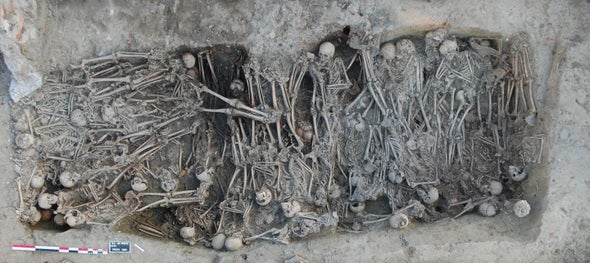(单词翻译:单击)
听力文本
This is Scientific American — 60-Second Science, I'm Susanne Bard.
The Black Death. Also known as the Great Plague, it spread across Europe between 1346 and 1353 and brought a swift but very painful demise to up to 60 percent of the population—perhaps 200 million people in all.
A bacterium called Yersinia pestis causes the plague. It's transmitted to humans by fleas. The insects hitched rides on the black rats that flourished along trade routes, aiding the spread of the plague.
"The Black Death was part of a larger pandemic that occurred in Europe and in the nearby regions between the 14th and 18th centuries. And it is, by many, considered to have been the most deadly of the three pandemics of plague that have occurred throughout our history."
Paleogeneticist Maria Spyrou of the Max Planck Institute for the Science of Human History.
"By analyzing ancient DNA from past pandemics and coupling that together with archeological and also historical evidence, we can really begin to build the history of those pandemics in great detail."
Spyrou and her team of disease detectives teamed up with archaeologists, looking for clues to the plague's arrival in Europe and its subsequent pattern of dispersal. Visiting old cemeteries across the continent, they sampled DNA from people who had likely succumbed to the plague—specifically, from their teeth.

"During a person's lifetime, the teeth have many blood vessels that are going through them, and they are sort of encapsulating any bacteria or viruses that may have affected the blood of this individual during their lifetime. And therefore, what we think is that by sampling those teeth, we have increased chances of really capturing the DNA of blood-borne pathogens like Yersinia pestis."
The researchers then reconstructed the genomes of the plague bacteria from different sites. Based on the location of the most ancestral strain of bacteria, they think the pathogen most likely first arrived in eastern Europe before spreading rapidly across the rest of the continent. But as it dispersed, Spyrou says, it picked up just a single genetic mutation.
"So in other words, what we think we're finding here is that the Black Death in Europe was caused by a single clone. So a single strain."
The finding suggests that the plague was introduced to Europe just one time. Only later in the pandemic did the pathogen diversify, creating local reservoirs of infectious agents across Europe. The study appears in the journal Nature Communications.
Spyrou says the strain of Yersinia pestis that set off the Black Death is now itself extinct. But its legacy is a sobering reminder of how a single microorganism can bring an entire continent to its knees.
Thanks for listening for Scientific American — 60-Second Science. I'm Susanne Bard.
参考译文
这里是科学美国人——60秒科学系列,我是苏珊娜·巴德。
黑死病。其也被称为大瘟疫,曾于1346年到1353年之间在欧洲蔓延,导致欧洲高达60%的人口迅速但痛苦地死亡,死亡总人数可能达到2亿人。
这场瘟疫由一种名为鼠疫杆菌的细菌引发。这种细菌通过跳蚤传染给人类。跳蚤寄生于在贸易线上繁衍生息的黑鼠身上,助长了瘟疫的传播。
“黑死病是14至18世纪在欧洲及附近地区爆发的更大规模的流行病的一部分。许多人认为这是人类历史上三次大瘟疫中最致命的一次。”
马克斯·普朗克人类历史科学研究所的古遗传学家玛丽亚·斯派尤说到。
“通过分析过去所爆发大流行病的古代DNA,并结合考古和历史证据,我们可以真正开始极为详细地构建这些大流行病的历史。”
斯派尤及其疾病检测团队与考古学家合作,寻找鼠疫抵达欧洲及后续传播模式的线索。他们走访了欧洲大陆各处的古老墓地,从可能感染鼠疫的人身上提取了DNA样本,准确地说,是从牙齿上提取样本。
“在人的一生中,有许多血管会经过牙齿,这些血管包裹着任何可能在一生中影响这个人血液的细菌或病毒。因此,我们认为通过对牙齿采样,我们就增加了真正捕获鼠疫杆菌等血源性病原体DNA的机会。”
然后,研究人员从不同位置重建了鼠疫细菌的基因组。根据最古老菌株的位置,他们认为病原体很有可能最先到达东欧,然后蔓延至欧洲大陆其他地方。但斯派尤表示,随着病菌的扩散,其只发生过一次基因突变。
“换句话说,我们认为我们的发现是,欧洲黑死病由单克隆引起。也就是由单一菌株引发。”
这项发现表明,鼠疫只在欧洲传播了一次。在这场疫情后期,病原体才开始多样化,导致欧洲各地形成传染源的局部储存宿主。这项研究发表在《自然通讯》期刊上。
斯派尤表示,引发黑死病的鼠疫杆菌现在已经灭绝。但其造成的后果却在警醒我们:单一微生物如何令整个大陆屈服。
谢谢大家收听科学美国人——60秒科学。我是苏珊娜·巴德。
译文为可可英语翻译,未经授权请勿转载!
重点讲解
重点讲解:
1. team up with (与…)组队;(与…)协作;
He didn't want to team up with anybody.
他不想与任何人合作。
2. succumb to 感染,死于(疾病);
A few years later, Katya succumbed to cancer in London.
几年后,卡佳因患癌症在伦敦病逝。
3. set off 引发;触发;激起;
The arrival of the charity van set off a minor riot as villagers scrambled for a share of the aid.
救济物资车的到来引发了小小的骚乱,村民们争先恐后地想抢到一份援助物资。
4. bring to one's knees 摧毁;使瘫痪;
Our aim is to bring this government to its knees, to force it to the negotiating table.
我们的目标是使该政府屈服,迫使它走上谈判桌。


